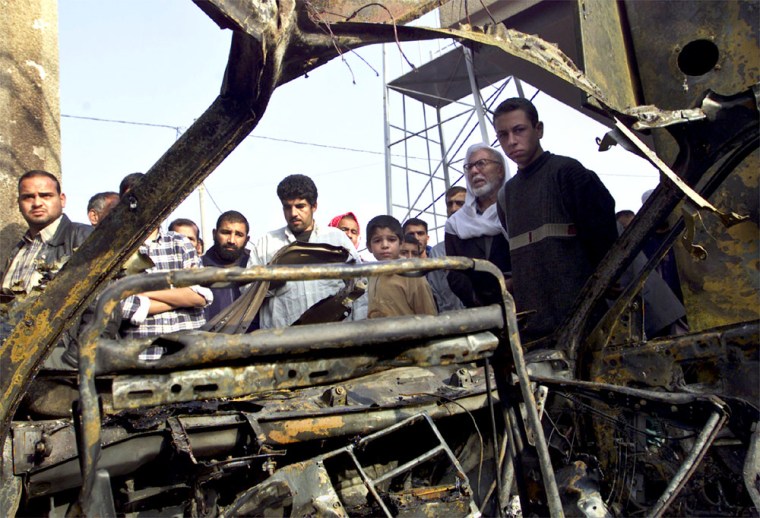A U.S. military helicopter made an emergency landing Tuesday in Fallujah, just hours after a car bomb attack on barracks near the northern city of Mosul wounded 41 U.S. soldiers, mainly with flying debris and glass. Elsewhere, a rocket attack on a Baghdad mosque killed three Iraqi civilians.
A military spokesman, who asked not to be identified, said the OH-58D Kiowa observation helicopter from the 82nd Airborne Division made a “controlled landing” at 2:30 p.m.
There were two crewmen on board and neither were injured, the spokesman said, adding that a quick-reaction force had secured the area.
An Associated Press reporter saw two helicopters flying in formation near the city, about 30 miles west of the capital, when one was hit by a grenade fired from the ground.
It went down immediately in an open field. The aircraft appeared structurally intact, but smoke was billowing from it. Two other helicopters with red crosses painted on the sides landed nearby a few minutes later, the reporter said.
In videotape shot shortly after the downing, an A-10 Thunderbolt II jet fighter was seen flying above. Several other Kiowas also circled the area, and a convoy of military vehicles drove toward the downed helicopter.
Fallujah, a hotbed of resistance to the U.S. occupation, sits in the heart of the dangerous Sunni Triangle where the majority of attacks on American forces have occurred since the ouster of former leader Saddam Hussein.
In past weeks there have been two other deadly attacks on U.S. helicopters.
On Nov. 2, 16 soldiers died when insurgents shot down a Chinook transport helicopter near Fallujah. In the deadliest single incident so far for U.S. soldiers, two Black Hawk helicopters collided and crashed in the northern city of Mosul on Nov. 17, killing 17 soldiers. U.S. commanders said the crash was caused by ground fire.
After the downing of those aircraft, the U.S. military introduced new tactics for its helicopters. These include flying at lower altitude, thus cutting down the time available to enemy gunners to take aim.
The Kiowa, a small observation and reconnaissance helicopter commonly seen in the skies over Iraq’s cities, carries one pilot and as many as four passengers.
SUICIDE CAR BOMB INJURES 41 TROOPS
In the Army base attack, a car drove to the gate of the barracks in the town of Talafar, 30 miles west of the northern city of Mosul.
Guards at the gate and in a watchtower opened fire on the vehicle and moments later it blew up. The bomb left a large crater at the gate’s entryway.
Col. Michael Linnington, commander of the 3rd Brigade which controls the area west of Mosul and all the way to the Syrian border, said the attack was a suicide mission and that the attacker’s remains were “all over the compound.”
“Right now we have four soldiers that were evacuated and are being treated for blast injuries. In addition, 37 soldiers have nicks, cuts, bruises and some broken bones,” he said. A base translator was also injured in the blast, which damaged nearby homes. Several other civilians, including a 2-year-old girl, were hurt by flying glass.
The early morning blast occurred when most soldiers were still in their barracks, and there was no traffic around the gate.
Pieces of the attacker’s car were scattered hundreds of meters away from the site of the blast. A school across the street from the military compound was heavily damaged, but no pupils were injured because the bomb exploded before classes began.
Hazem Ismail, a 40-year-old school teacher, said several pieces of the car hit his house, shattering the window of room where his five children were sleeping.
“The kids woke up terrified from their beds, but thank God none of them were harmed,” he said.
Meanwhile, three U.S. soldiers from the 2nd Infantry Division’s 3rd Brigade died and one was injured in an accident when an embankment collapsed beneath their armored personnel carriers north of Baghdad, the military said Tuesday.
The deaths bring to 448 the number of U.S. soldiers who have died in Iraq since the U.S.-led invasion on March 20. Of those, 308 have died as a result of hostile action.
MOSQUE ATTACK KILLS 3 IRAQIS
In Baghdad, three people were killed and two injured early Tuesday when a missile exploded in the courtyard of a mosque in the capital’s western Hurriyah district, police said.
Ahmed Hussein, the mosque’s prayer leader, said the explosion occurred at 6:45 a.m. and that it damaged the building and several cars parked nearby.
“Those who carried out the attack have nothing to do with any religion,” said Farouk Khamis, the mosque’s imam. “They are ordinary criminals who targeted believers doing their prayers.”
Also in Baghdad, about 250 people rallied Tuesday in the center of town to protest the death of a Shiite cleric, who they said was struck by a tank Friday while standing in the street in the mainly Shiite Sadr City district.
The protesters chanted “No, no to America,” and demanded that the U.S. military apologize for Sheik Abdel Razzaq al-Lami’s death and bring to trial those responsible.
The U.S. military had no immediate comment on the incident.
